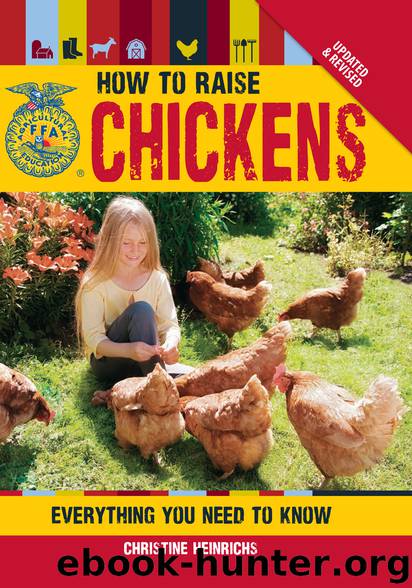The How to Raise Chickens by Christine Heinrichs

Author:Christine Heinrichs
Language: eng
Format: epub
Publisher: MBI
Published: 2013-03-11T04:00:00+00:00
These bantam Mille Fleur d’Uccle hens have no trouble flying up to lay their eggs in the top nest boxes.
COLD-WEATHER CHICKENS
Bigger birds do better in the cold. Jersey Giants, at 13 pounds for a rooster, 10 pounds for a hen, don’t mind the cold.
Sometimes the biggest challenge is keeping the chickens’ water from freezing. Electric water dishes are available. Make sure your chickens have fresh water available.
Chanteclers were developed in Canada and remain the only recognized Canadian breed. Their small, low, cushion combs and almost nonexistent wattles are well suited to cold weather. They are good winter layers. Cocks weigh more than 8 pounds and hens more than 6.
Wyandottes were developed in New York State in the 1870s, another location known for cold winter weather. They feather out well and come in several colors, and they are a good dual-purpose breed.
Dominiques, with their rose combs, are reliable and sturdy. They have a long history in the United States going back to Colonial times, so they have survived many cold winters. They are good winter layers, good broody hens and good mothers.
Javas, a foundation breed that traces its roots to that Southeast Asian island, nevertheless do well in cold American weather.
Buckeyes are named for the Buckeye state and the Buckeye whose color they have. With their pea combs, they are well suited to those cold Ohio winters and are a good all-around breed.
Norwegian Jaerhons are a long established Scandinavian breed that was standardized in the twentieth century. They are smaller, 5 pounds for cocks and 3.5 pounds for hens, with attractive patterns. They are a good choice for a hardy dual-purpose breed.
Faverolles are a French composite dual-purpose breed that was developed for winter egg-laying. Their eggs are light brown. They are hefty birds, with mature cocks weighing in at 8 pounds or more and hens at 7 pounds. They are the only breed with the Salmon color variety, a pattern of bright contrasting colors on the males and more demure brown and cream on the females.
White Dorkings are recognized as a rose comb variety. Other unrecognized Dorking varieties also have rose combs.
Rhodes Island Reds are recognized in a rose-comb variety, and Rhode Island Whites have rose combs. Hamburgs are a rose-combed breed that has been known in the past as the “Dutch Everyday Layer.”
Icelandic chickens are the chickens of the Vikings, a landrace rather than a breed developed through selective breeding. They are small, almost banty size, but good winter layers of white eggs. Their Icelandic name, íslenka landnámshænan, means “Icelandic hen of the settlers.” They are long-lived, hardy foragers. The hens are good broodies. Their color patterns, combs, and leg colors are not standardized, and the breed is not recognized for exhibition. They are quite rare but would make a good choice for a cold-climate flock.
Kraienkoppes are another unrecognized breed that is winter-hardy and a good layer. Small, at around 5 or 6 pounds, they are good foragers that prefer some free range in their lives. Their history in the Netherlands and Germany explains their resilience in cold weather.
Download
This site does not store any files on its server. We only index and link to content provided by other sites. Please contact the content providers to delete copyright contents if any and email us, we'll remove relevant links or contents immediately.
| Automotive | Engineering |
| Transportation |
Whiskies Galore by Ian Buxton(41517)
Introduction to Aircraft Design (Cambridge Aerospace Series) by John P. Fielding(32879)
Small Unmanned Fixed-wing Aircraft Design by Andrew J. Keane Andras Sobester James P. Scanlan & András Sóbester & James P. Scanlan(32563)
Craft Beer for the Homebrewer by Michael Agnew(17921)
Turbulence by E. J. Noyes(7687)
The Complete Stick Figure Physics Tutorials by Allen Sarah(7132)
Kaplan MCAT General Chemistry Review by Kaplan(6579)
The Thirst by Nesbo Jo(6427)
Bad Blood by John Carreyrou(6265)
Modelling of Convective Heat and Mass Transfer in Rotating Flows by Igor V. Shevchuk(6216)
Learning SQL by Alan Beaulieu(6019)
Weapons of Math Destruction by Cathy O'Neil(5812)
Man-made Catastrophes and Risk Information Concealment by Dmitry Chernov & Didier Sornette(5635)
Digital Minimalism by Cal Newport;(5368)
Life 3.0: Being Human in the Age of Artificial Intelligence by Tegmark Max(5171)
iGen by Jean M. Twenge(5147)
Secrets of Antigravity Propulsion: Tesla, UFOs, and Classified Aerospace Technology by Ph.D. Paul A. Laviolette(4968)
Design of Trajectory Optimization Approach for Space Maneuver Vehicle Skip Entry Problems by Runqi Chai & Al Savvaris & Antonios Tsourdos & Senchun Chai(4835)
Electronic Devices & Circuits by Jacob Millman & Christos C. Halkias(4735)
